2014新版八年级英语下册第1-----第10单元知识点总结
Unit1-Unit10单元知识点人教版英语八年级下册
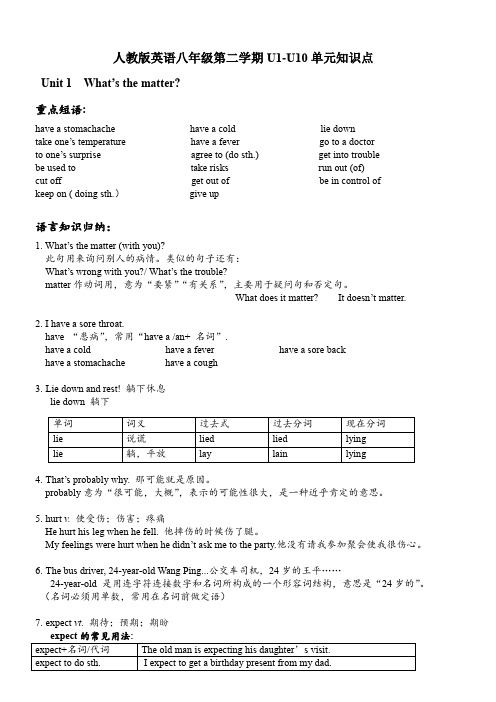
人教版英语八年级第二学期U1-U10单元知识点Unit 1 What’s the matter?重点短语:have a stomachache have a cold lie downtake one’s temperature have a fever go to a doctorto one’s surprise agree to (do sth.) get into troublebe used to take risks run out (of)cut off get out of be in control ofkeep on ( doing sth.)give up语言知识归纳:1. What’s the matter (with you)?此句用来询问别人的病情。
类似的句子还有:What’s wrong with you?/ What’s the trouble?matter作动词用,意为“要紧”“有关系”,主要用于疑问句和否定句。
What does it matter? It doesn’t matter.2. I have a sore throat.have “患病”,常用“have a /an+ 名词”.have a cold have a fever have a sore backhave a stomachache have a cough3.Lie down and rest! 躺下休息lie down 躺下4.That’s probably why. 那可能就是原因。
probably意为“很可能,大概”,表示的可能性很大,是一种近乎肯定的意思。
5.hurt v.使受伤;伤害;疼痛He hurt his leg when he fell. 他摔伤的时候伤了腿。
My feelings were hurt when he didn’t ask me to the party.他没有请我参加聚会使我很伤心。
八年级下册英语知识梳理unit1-10
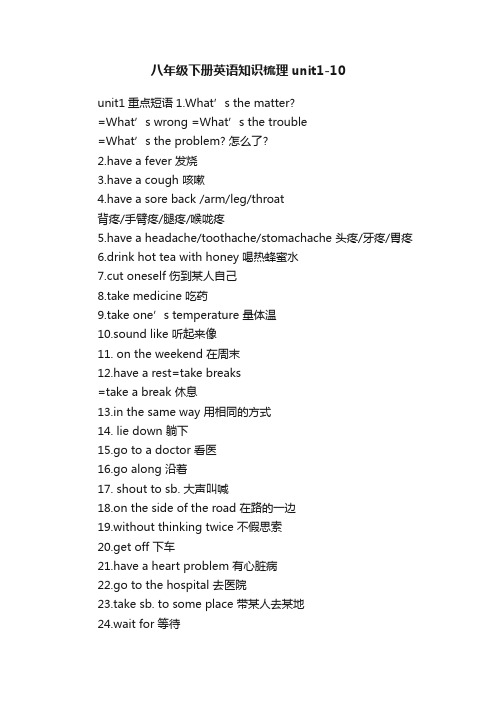
八年级下册英语知识梳理unit1-10unit1重点短语1.What’s the matter?=What’s wrong =What’s the trouble=What’s the problem? 怎么了?2.have a fever 发烧3.have a cough 咳嗽4.have a sore back /arm/leg/throat背疼/手臂疼/腿疼/喉咙疼5.have a headache/toothache/stomachache 头疼/牙疼/胃疼6.drink hot tea with honey 喝热蜂蜜水7.cut oneself 伤到某人自己8.take medicine 吃药9.take one’s temperature 量体温10.sound like 听起来像11. on the weekend 在周末12.have a rest=take breaks=take a break 休息13.in the same way 用相同的方式14. lie down 躺下15.go to a doctor 看医16.go along 沿着17. shout to sb. 大声叫喊18.on the side of the road 在路的一边19.without thinking twice 不假思索20.get off 下车21.have a heart problem 有心脏病22.go to the hospital 去医院23.take sb. to some place 带某人去某地24.wait for 等待25. to one’s surprise 令某人吃惊的是26.argee to do sth. 同意做某事27.move onto 把…移动到28.thans to 由于28.in time 及时29.right away 马上30.get into trouble 陷入麻烦31.get an X ray 照X光32.have a try 试一试33.have a party 举行聚会34.fall down 摔倒35.have trouble doing sth=have difficulty doing sth=have problems doing sth 做某事有困难36.feel sick 感到不舒服37.enjoy oneself 玩得高兴38.say to oneself 自言自语39.leave sb by oneself 把某人单独留下40.lose oneself in 沉醉于41.take care of =look after 照顾42.get hit on the head 打到头43.put on 穿上 44.get sunburned 晒伤45.be interested in 对……感兴趣46.because of 因为 47.cut off 切除48.be in a difficult situation 处于困难的状况之中49.the importance of ……的重要性50.get out of 离开51.make good decisions 做决定52.be in control of 控制 53.the same as 和……相同54.give up 放弃55.see sb do sth 看见某人做过某事56.see sb doing sth 看见某人正在做某事unit1重点语法:1.enough: 名词放在enough 后面,形容词或副词放在enough 前面enough money old enough2.be used to doing sth 习惯于做某事used to do sth 曾经做过某事3.so ……that 如此..以至于 so that 以便,为了Eg:I was so tired that I fell asleep quickly.我是如此的累以至于我很快睡着了Eg:I work hard so that I can get a good grade 我努力学习是为了我可以取得一个好成绩4.run out物体做主语5.run out of 人做主语I ran out of my money.我用完了我的钱=My money ran out. 我的钱用完了Unit 21.do the chores 干家务2. 2.do the dishes 洗餐具3.take out the rubbish 倒垃圾4.fold the clothes 折衣服5.sweep the floor 扫地板6.make the bed 整理床铺7.clean the living room 打扫客厅8.water the plant 浇水9.wash the car 洗车10.work on 从事于·····;在····上工作11.work out 解决12.help out with 帮助做13.at least 至少14.enough money 足够的钱15.old enough 足够老16.finish doing sth 结束做某事/doc/278ba8ee960590c69ec376fc.html e from 来自18.throw down 扔下19.throw to 扔给/doc/278ba8ee960590c69ec376fc.html e over 过来21 take the dog for a walk 遛狗22.all the time 一直23.all day 整天24.as·····as 和·······一样25.in surprise 吃惊的26. share the housework 分担家务27.neither······nor···既不···也不···28.as soon as 一···就···29.hang out 闲逛30.pass sb sth 递给某人某物31.lend to 借给32.borrow····from··从····借33.invite sb to do sth 邀请某人做某事34.invite sb to some place 邀请某人去某地35.look through 阅览36.spend on 用在37 a waste of time 浪费时间38.pass sth to sb 递给某人某物39.in order to 为了40.get good grades 取得好成绩42.spend (in)doing sth 用做某事43.provide sth for sb向某人提供44.provide sb with sth 提供给某人45.mind doing sth 介意做某事46.depend on 依靠47.have no idea不知道48.don’t know 不知道49 fall ill 生病50.ask sb not to do sth 告诉某人不要做某事51.It takes sb some time to do sth 做某事花费某人多长时间52.stay out late 待在外面很晚53.get a ride 搭车句子1.委婉请求:could you please do···?(情态动词加动词原形)Eg:Could you please clean your room?答语:Sorry ,I can’t. / All right . / No problem. With pleasure. / Certainly. /Yes,sure.表示委婉请求的句子1.Would you like to do sth ?2.Would you mind doing sth?3.Let us do sth .4.please do sth2情态动词Need I finish doing my housework?Yes,you must. /No,you needn’t.Must I finish doing my housework?Yes,you must. /No,you needn’t.3.as·····as 和····一样eg:I am just as tired as you (are).4.否定句,也不 neither/nor+助/情态动词+主语1.She did not do any housework and neither do I2.My brother can not play the piano and neither do I. 肯定句,也so+助+主My mother likes bananas and so do I.5.两者都不 neither1.What color do you like , white or black?Neither , I like red.2.Neither of us goes to school.Neither ·····nor·····既不·····也不eg:The weather in Kunming is neither hot nor cold. 7.宾语从句用陈述句语序Can you tell me where Deng Yunxiang comes from ?8.There is no need for sb to do sth.9.It is +adj+for sb+to do sth10.the+比较级······the+比较级越…就越…The healthier ,the better 越健康,就越好Unit 31.volunteer 志愿做2.sign 标志3.notice 通知4.lonely 孤独的5.several 几个6.strong 强烈的7.feeling 感觉 8.satisfaction 满足9.joy 高兴 10.owner 物主11.journey 旅行 12.raise 募集13.alone=by oneself 单独 14.repair 修理15.fix 修理 16.broken 破损的17.wheel 车轮 18.disabled 有残疾的19.blind 瞎的 20.deaf 聋的21.imagine 想象 22.difficulty困难23.carry 拿 24.train 训练(v)25.training 训练(n) 26.kindness 仁慈27.understand 明白 28.change 变化重点句子1. We need to come up with a plan to tell people about the city park clean up.2.We can't put off making a plan.3.I mean,we're all going to be old one day,too.4.They told me stories about the past and how things used to be.5.I get such a strong feeling of satisfaction when I see the animals get better and look of their owner’s faces.6.I can do what I love to do and help others at the same time.7.You helped to make it possible for me to have lucky.8.What would it be like to be blind and deaf?UNIT 41.allow sb (not) to do sth (不)允许某人做某事eg:My parents don't allow me to hang out .2.what's wrong? =what's the matter/ trouble/ problem? 哪儿不舒服?3.look through浏览4.big deal重要的事5.work out 解决;work on 致力于6.get on with和睦相处/doc/278ba8ee960590c69ec376fc.html pare with 比较Eg.My parents are always comparing me with other kids .8.in one’s opinion 依...看9.cut out 删除10.not…until 直到...才11.on zhe phone 在电话上12.so that 以便于/so…that 如此...以至于13.find sb ding sth 发现某人做某事14.give it/them back=return 把...归还15.angry with sb 和某人生气16.argue with sb 和某人争吵17.all the time 一直;反复/doc/278ba8ee960590c69ec376fc.html municate with sb和某人交流19.have time to do sth/have time for sth.有时间做某事eg:they have time for proper communication./they have time to communicate properly.20.it's time to do sth/it's time for sth .到了该做某事的时间eg:It's time to have English class./It's time for English class.21.Why don't you do sth?=why not do sth?你为什么不做某事呢?22.too many 太多(+可数名词的复数形式)eg: There are re too many apples.23.too much 太多(+不可数名词)eg:I ate too much yesterday.much too太...(+adj/adv)eg:He's much too fat for his age.23.offer to do sth=offer sb sth=offer sth to sb主动帮助做某事24.provide sb with sth=provide sth for sb主动向某人提供某物25.explain to sb 向某人解释26.take...to... 把...带到...27.continue to do sth 继续做另一件事/ continue doing sth继续做刚才做的事28.join+人/组织 join sb in+活动=take part in29.be good at 擅长于 be good for对...有好处be good with和某人相处得好30.What/How adout doing sth?Would you like to do sth?31.be nervous about 对...感到紧张32.so that+完整的句子/in order to+短语eg: You should call him so that you can say sorry. We study hard in order to have a good future. Unit 5重点短语● 1.at the bus stop 在公交车站● 2.wait for the bus 等公交车● 3.walk home 走路回家● 4.go off 发出响声● 5.take a hot shower 洗一个热水澡● 6.miss the bus 错过公共汽车●7.pick up the phone 接电话●8.answer the phone 接电话●9.so many times 如此多次●10.wind 风(可数名词)●11.make sure 确认●12.serious storm 严重的暴风雨●13.at first起初●14.fall asleep 入睡●15.wake up 醒来●16.beat…against 对···敲打●17.bring…closer 拉近距离●18.break…apart 拆散● 19.in times of difficulty 在困难时期20.at that time 在那时●21.by the side of road 在路边●22.on the radio 在收音机上●23.the rest of 剩下的●24.in silence 沉默●25.look out 向外看●26.look out of the window 向窗外看过去进行时1.标志:at 8:00 yesterday, at the time of, at that time2.结构 : was/were+doing sth3.注意: when引导的时间状语从句,从句用一般过去时,主句用过去进行时。
2014新版八年级英语下册第一至第五单元知识点复习总结
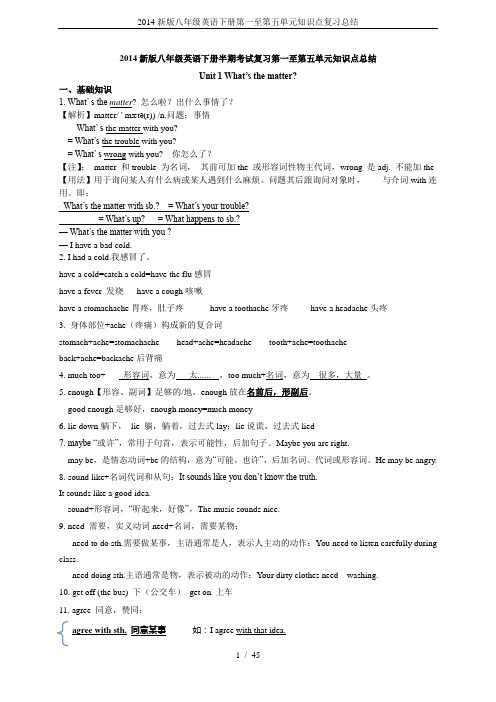
2014新版八年级英语下册半期考试复习第一至第五单元知识点总结Unit 1 What’s the matter?一、基础知识1. What’ s the matter? 怎么啦?出什么事情了?【解析】matter/ ' mætə(r)) /n.问题;事情What’ s the matter with you?= What’s the trouble with you?= What’ s wrong with you? 你怎么了?【注】:matter 和trouble 为名词,其前可加the 或形容词性物主代词,wrong 是adj. 不能加the 【用法】用于询问某人有什么病或某人遇到什么麻烦、问题其后跟询问对象时,与介词with连用。
即:What’s the matter with sb.? = What’s your trouble?= What’s up? = What happens to sb.?—What’s the matter with you ?— I have a bad cold.2. I had a cold.我感冒了。
have a cold=catch a cold=have the flu感冒have a fever 发烧have a cough咳嗽have a stomachache胃疼,肚子疼have a toothache牙疼have a headache头疼3. 身体部位+ache(疼痛)构成新的复合词stomach+ache=stomachache head+ache=headache tooth+ache=toothacheback+ache=backache后背痛4. much too+ 形容词,意为太...... ,too much+名词,意为很多,大量。
5. enough【形容、副词】足够的/地,enough放在名前后,形副后。
good enough足够好,enough money=much money6. lie down躺下,lie 躺,躺着,过去式lay;lie说谎,过去式lied7. maybe “或许”,常用于句首,表示可能性,后加句子。
2014年春八年级英语下册复习提纲1---10单元书面表达

Unit 1 What’ the matter ?第一单元书面表达★你的朋友Jack由于长时间玩电脑游戏,现在头痛、眼睛不舒服、腰背酸痛,并且睡不好觉。
写一篇短文介绍一下他的情况,并给出你对他的建议。
要求:(1)内容包含所提供的信息,可适当发挥;(2)书写认真,句子通顺;(3)词数:60词左右。
★Jack is my friend. He likes playing computer games very much. He often sits in the same way for too long without moving. Now he has a headache, sore eyes and a sore back. He doesn’t sleep well at night, so he feels tired every day.I think he should take breaks away from the computer. He shouldn’t use the computer for a long time. He should do eye exercises to relax his eyes and go to bed early at night.I think if he has a good rest, he will feel well soon.★假如你是Gina, Judy的老师,表格内容是你根据他们的问题提出的一些建议。
写一篇60词左右的短文。
Problem should shouldn'tGa tired Go to bed Watch too much TVJu fat Take moreexercise eat too much meat and junk foodGina always feels tired because she likes watching TV. So my advice is that she should go to bed early and she shouldn't watch too much TV so that she can get enough sleep and she will feel energetic next day.Julie is a bit fat so she should take more exercise and she shouldn't eat too much meat and junk food.Unit 2 I’ll help to clean up the city parks .第二单元书面表达★根据汉语提示及要求,以Lily’s Dream为题写一篇短文.提示: 1.lily是一个中学生,她想成为一名职业演员. 2.她同时也是一名志愿者,经常参加一些志愿者服务活动,业余时间她还上表演课. 3.现在她遇到了一些麻烦,无钱上表演课.她想出了许多办法,如: 打电话给家长、主动辅导孩子的美术、张贴启事寻找工作挣钱等。
期末Units1-10单元知识点总结 人教版八年级英语下册
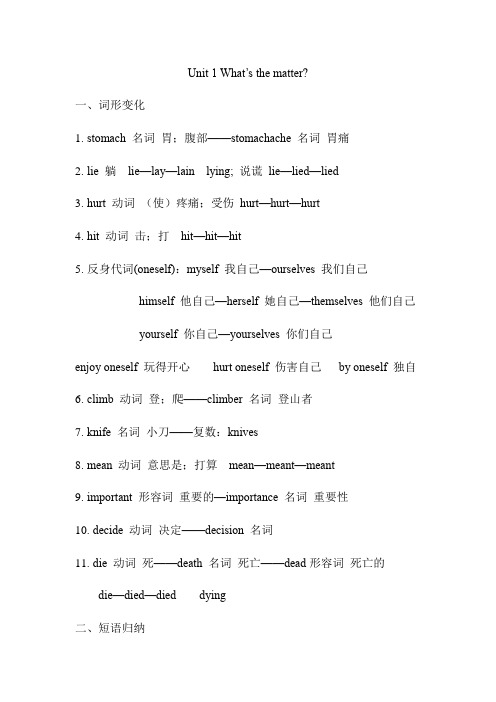
Unit 1 What’s the matter?一、词形变化1.stomach 名词胃;腹部——stomachache 名词胃痛2.lie 躺lie—lay—lain lying; 说谎lie—lied—lied3.hurt 动词(使)疼痛;受伤hurt—hurt—hurt4.hit 动词击;打hit—hit—hit5.反身代词(oneself):myself 我自己—ourselves 我们自己himself 他自己—herself 她自己—themselves 他们自己yourself 你自己—yourselves 你们自己enjoy oneself 玩得开心hurt oneself 伤害自己by oneself 独自6.climb 动词登;爬——climber 名词登山者7.knife 名词小刀——复数:knives8.mean 动词意思是;打算mean—meant—meant9.important 形容词重要的—importance 名词重要性10.decide 动词决定——decision 名词11.die 动词死——death 名词死亡——dead形容词死亡的die—died—died dying二、短语归纳1.lie down 躺下to one’s (my/his/her...) surprise 令某人惊讶的是2.take one’s (my/your/his/her..) temperature 量体温3.take a break = take breaks 休息take a risk = take risks冒险4.run out 物做主语:The money ran out. 钱用光了。
run out of 人做主语:I ran out of money. 我用光了钱。
5.make a decision = make decisions 做决定6.be in control of 掌管He is in control of the company. 他掌管公司。
人教版八年级下册英语 Unit 1-Unit 10 各单元语法知识点复习提纲(全面!)

人教版八年级下册英语Unit 1-Unit 10 各单元语法知识点复习提纲Unit 1重点短语be in control of 掌管;管理because of 由于fall down 摔倒feel sick 感到恶心get an X-ray 拍X 光片get into trouble 造成麻烦get off 下车get out of 离开;从……出来give up 放弃go along 沿着……走go to a doctor 看医生have a cold 受凉;感冒have a cough 咳嗽have a fever 发烧have a heart problem 有心脏病have a nosebleed 流鼻血have a sore back 背疼have a sore throat 喉咙痛have a stomachache 胃疼have a toothache 牙疼have problems breathing 呼吸困难hot tea with honey 加蜂蜜的热茶in a difficult situation 在闲境中in the same way 以同样的方式in time 及时keep on doing sth. 继续或坚持做某事make a decision 做出决定on the side of the road 在马路边right away 立刻;马上run out (of) 用完;用尽see a dentist 看牙医shout for help 大声呼救so that 以便so...that... 如此……以至于……sound like 听起来像take one's temperature 量体温take risks 冒险talk too much 说得太多thanks to 多亏了;由于to one's surprise 另某人惊讶的是without thinking twice 没有多想词法精选1.I have a stomachache.我胃痛。
人教版八年级下册英语Unit 1 -Unit 10 各单元重点短语总结(实用!)

人教版八年级下册英语Unit 1 -Unit 10 各单元重点短语总结Unit 1 What’s the matter?【重点短语】1.have a fever 发烧2.have a cough 咳嗽3.have a toothache牙疼4.talk too much 说得太多5.drink enough water 喝足够的水6.have a cold 受凉;感冒7.have a stomachache 胃疼8.have a sore back 背疼9.have a sore throat 喉咙痛10. take risks冒险11.hot tea with honey 加蜂蜜的热茶A house with a garden12.see a dentist 看牙医13.get an X-ray 拍X 光片14.take one’ s temperature 量体温15.put some medicine on sth. 在……上面敷药16. give up doing sth 放弃17. sound like 听起来像18. all weekend 整个周末19. in the same way以同样的方式20. go to a doctor 看医生21. go along the street沿着……走22. on the side of the road 在马路边23. shout for help 大声呼救shout at sb.24. without think ing twice 没有多想25. get off 下车get on26. have a heart problem 有心脏病27. to one’ s su rprise另某人惊讶的是to my surprise28.thanks to多亏了;由于=Because of =due to29.in time 及时On time 按时30. make a decision 做出决定31. get into trouble造成麻烦32. right away 立刻;马上33. because of 由于34. get out of 离开;从……出来35. keep on doing sth.继续或坚持做某事36. put a bandage on sth. 用绷带包扎37. fall down 摔倒38. feel sick 感到恶心A sick dog = The dog is ill.39. have a nosebleed 流鼻血40. cut his knee割伤他的膝盖41. put her head back 把她的头向后仰42. have problems breathing呼吸困难43. mountain climbing 登山运动44. be used to doing sth.习惯做某事Be used to do sth.被用来Used to do sth.过去常常做某事45. run out (of) 用完;用尽46. so that 以便47. so...that... 如此……以至于...…48. be in control of 掌管;管理49. in a difficult situation 在闲境中【重点句型】1. What's the matter with you?= What's the trouble with you?= What's wrong with you? 你怎么了?2. What should she do? 她该怎么办呢?3.Should I take my temperature? 我应该量一下体温吗?4.You should lie down and rest. 你应该躺下休息一会儿。
八下unit1-unit10知识点
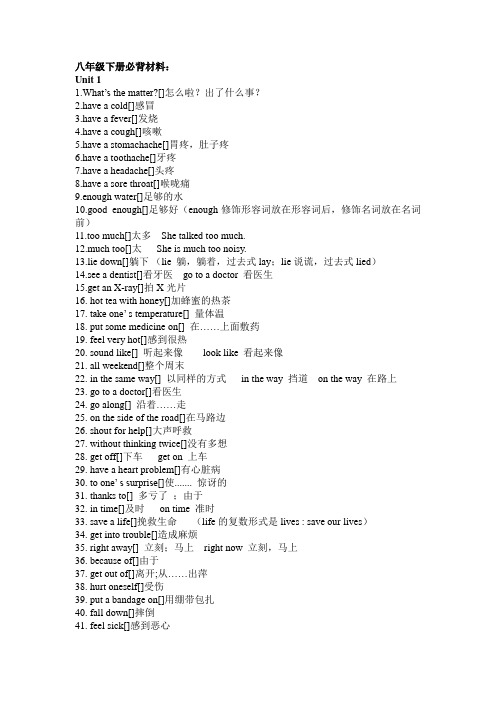
八年级下册必背材料:Unit 11.What’s the matter?[]怎么啦?出了什么事?2.have a cold[]感冒3.have a fever[]发烧4.have a cough[]咳嗽5.have a stomachache[]胃疼,肚子疼6.have a toothache[]牙疼7.have a headache[]头疼8.have a sore throat[]喉咙痛9.enough water[]足够的水10.good enough[]足够好(enough修饰形容词放在形容词后,修饰名词放在名词前)11.too much[]太多She talked too much.12.much too[]太She is much too noisy.13.lie down[]躺下(lie 躺,躺着,过去式lay;lie说谎,过去式lied)14.see a dentist[]看牙医go to a doctor 看医生15.get an X-ray[]拍X光片16. hot tea with honey[]加蜂蜜的热茶17. take one’ s temperature[] 量体温18. put some medicine on[] 在……上面敷药19. feel very hot[]感到很热20. sound like[] 听起来像look like 看起来像21. all weekend[]整个周末22. in the same way[] 以同样的方式in the way 挡道on the way 在路上23. go to a doctor[]看医生24. go along[] 沿着……走25. on the side of the road[]在马路边26. shout for help[]大声呼救27. without thinking twice[]没有多想28. get off[]下车get on 上车29. have a heart problem[]有心脏病30. to one’ s surprise[]使....... 惊讶的31. thanks to[] 多亏了;由于32. in time[]及时on time 准时33. save a life[]挽救生命(life的复数形式是lives : save our lives)34. get into trouble[]造成麻烦35. right away[] 立刻;马上right now 立刻,马上36. because of[]由于37. get out of[]离开;从……出萍38. hurt oneself[]受伤39. put a bandage on[]用绷带包扎40. fall down[]摔倒41. feel sick[]感到恶心42. have a nose bleed[] 流鼻血43. cut his knee[]割伤他的膝盖44. put her head back[]把她的头向后仰45. have problems breathing[]呼吸困难46. mountain climbing[] 登山运动47. be used to doing[] 习惯做某事48. run out[] 用完;用尽run out of 用完,用尽49. so that[]以便50. so. . . that[]如此… …以至于…51. be in control of[]掌管;管理52. in a difficult situation[]在困境屮53. keep on doing[]继续或坚持做某事54. make a decision[] 做出决定55. take risks[]冒险56. give up[] 放弃Unit 21.clean up[]打扫干净Clean-Up Day 清洁日clean 干净的adj. 打扫v.2.cheer up [](使)变得高兴;振奋起来3.give out[]分发give in 投降give off 释放,发出give up 放弃give back 归还4.after-school reading program[]课外阅读项目5.homeless[]无家可归的adj. careless 粗心的harmless 无害的useless 无用的e up with[]想出;提出7.make a plan[]制订计划make some plans 制定一些计划8.put off[]推迟;延迟put up 张贴,举起put out 熄灭put away 收好9.write down[]写下10.make some notices[]做些公告牌11.hand out[]分发;散发;发给12.call up[]打电话;召集13.an old people’s home[]养老院14.help out with something[]帮助解决困难ed to[]曾经;过去常常16.sound interesting[]听起来有趣17.lonely[]孤独的adj. (feel lonely) alone 独自adv. (live alone)18.care for[]关心;照顾19.a strong feeling of satisfaction[]强烈的满足感satisfy 使满意,使满足v.20.the look of joy[]快乐的表情21.at the age of[]在......岁时22.decide to do something[]决定做某事decision 决定n.23.try out[]试用;试行24.at the same time[]同时25.volunteer to do something[]志愿做某事26.work for[]为…工作;为…. 效力27.for example[]比如;例如28.raise money[]筹钱;募捐29.take after[]与......相像;像30.give away[]赠送;捐赠31.fix up[]修理;修补;解决修理:repair ,fix,mend32.be similar to[]与……相似33.set up[]建立;设立34.disabled people[]残疾人35.make a difference[]影响;有作用36.be able to[]能够(可用于各种时态,有人称和数的变化)37.at once[]立刻,马上相当于right now right awayUnit 31.go out for dinner[] 出去吃饭2.stay out late[]在外面待到很晚3.go to the movies[]去看电影4.get a ride[]搭车5.work on[] 从事6.finish doing something[] 完成做某事7.clean and tidy[] 干净整洁8.do the dishes[] 洗餐具9.take out the rubbish[]倒垃圾10.fold the clothes[]叠衣服11.sweep the floor[]扫地12.make the bed[]整理床铺13.clean the living room[]打扫客厅14.no problem[] 没问题15.welcome somebody[] 欢迎某人e home from school[]放学回家e home from work[]下班回家18.throw down[] 扔下19.sit down[]坐下e over[] 过来21.take somebody for a walk[] 带某人去散步22.all the time[]一直;总是23.all day[]整日24.do housework[] 做家务25.shout back[]大声回应26.walk away[]走开27.share the housework[]分担家务28.a comfortable home[]一个舒适的家29.in surprise[]惊讶地30.get something to drink[]拿点喝的东西31.watch one show[] 观看一个节目32.hang out[]闲逛33.pass somebody something[]把某物传给某人34.pass something to somebody[]把某物传给某人35.lend somebody something[]把某物借给某人36.lend someyhing to somebody[]把某物借给某人37.get something wet[] 使某物弄湿38.hate to do something[] 讨厌做某事39.do chores[] 做杂务40.help somebody do sth[]帮助某人干某事41.bring a tent[]带顶帐篷来42.buy some snacks[]买些小吃43.go to the store[]去商店44.invite somebody to a party[]邀请某人参加聚会45.make somebody do something[]使某人做某事46.enough stress[]足够的压力47.waste of time[]浪费时间48.in order to[]为了49.get good grades[]取得好成绩50.mind doing something[]介意做某事51.depend on[]依赖;依靠52.develop children’s independence[]发展孩子的独立性53.look after[]照顾;照看54.take care of[]照顾;照看55.do one’s part in (doing ) something[]做某人分内的事unit 41.have free time[] 有空闲时间2.allow somebody to do something[] 允许某人做某事3.hang out with somebody[]与某人闲逛4.after-school classes[]课外活动课5.get into a fight with somebody[]与某人吵架/打架6.until midnight[]直到半夜7.talk to somebody[]与某人交谈8.too many[]太多9.study too much[] 学得过多10.get enough sleep[]有足够的睡眠11.write somebody a letter[]给某人写信12.call somebody up[]打电话给某人13.surprise somebody[] 令某人惊讶14.look through[]浏览15.be angry with somebody[]生某人的气16.a big deal[] 重要的事17.work out[]成功地发展;解决18.get on with[]和睦相处;关系良好:19.fight a lot[] 经常吵架/打架20.hang over[]笼罩21.refuse to do something[] 拒绝做某事22.offer to do something[]主动提出做某事23.so that[]以便24.mind somebody doing something[]介意某人做某事25.all the time[]一直26.in future[]今后27.make somebody angry[] 使某人生气28.worry about something[] 担心某事29.copy one’ s homework[] 抄袭某人的作业30.be oneself[]做自己31.family members[]家庭成员32.spend time alone[]独自消磨时光33.give somebody pressure[]给某人施压34.have a fight with somebody[]与某人吵架pete with somebody[]与某人竞争36.free time activities[]业余活动37.get better grades[]取得更好的成绩38.give one’ s opinion[] 提出某人的观点39.learn exam skills[]学习应试技巧40.practice sports[] 体育训练41.cause stress[]造成压力42.cut out[] 删除43.allow somebody to do something[]允许某人做某事44.why don’t you do something[]为什么不做某事45.want to do something[]想要做某事46.find somebody doing something[]发现某人正在做某事47.find somebody do something[]发现某人做过某事48.see somebody doing something[]看见某人正在做某事49.see somebody do something[]看见某人做过某事50.tell somebody to do something[]让某人做某事51.make somebody do something[]让某人做某事52.let somebody do something[]让某人做某事53.keep somebody doing something[]让某人做某事54.refuse somebody to do something[]拒绝做某事55.offer to do something[]主动做某事56.mind somebody doing something[]介意某人做某事57.not…until…[]直到...才...58.it’s time to do something[]到了做某事的时间59.keep on doing something[]持续做某事60.what do you think of[]你怎么看unit 51.wait for the bus[]等公交车(注意介词for后面接等的对象)2.wait at the bus stop[]在公交车站等(注意介词at后面接等的地点)3.go off [](闹钟)发出响声4.miss the bus[]错过公交车5.at the time of[]当.......时候6.pick up[]接电话;接送;捡;摘;学习7.take a hot shower[]洗热水澡8.rain heavily[]下大雨(副词修饰动词)9.in the area[]在这个地区10.make sure[]确信;确认11.beat against...[]拍打… …12.fall asleep[]进人梦乡;睡着13.die down[]逐渐变弱;逐渐消失(注意die的现在分词形式为dying)14.wake up[]醒来15.The sun was rising.[]太阳正在升起。
八年级下册1-10单元重点短语等知识点归纳
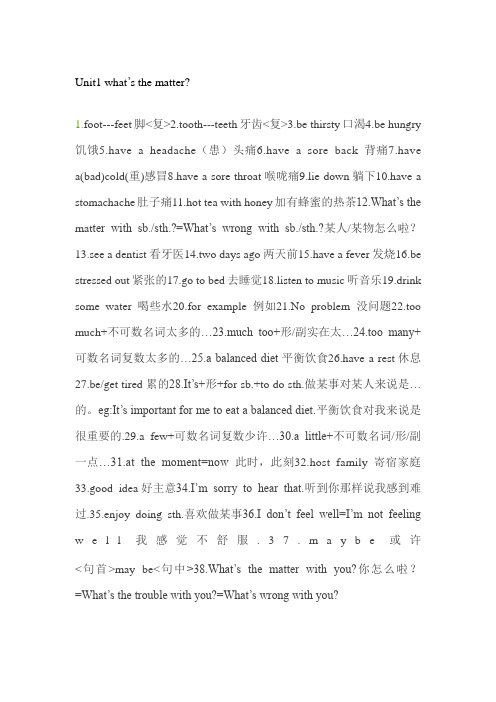
Unit1 what’s the matter?1.foot---feet脚<复>2.tooth---teeth牙齿<复>3.be thirsty口渴4.be hungry 饥饿5.have a headache(患)头痛6.have a sore back背痛7.have a(bad)cold(重)感冒8.have a sore throat喉咙痛9.lie down躺下10.have a stomachache肚子痛11.hot tea with honey加有蜂蜜的热茶12.What’s the mat ter with sb./sth.?=What’s wrong with sb./sth.?某人/某物怎么啦?13.see a dentist看牙医14.two days ago两天前15.have a fever发烧16.be stressed out紧张的17.go to bed去睡觉18.listen to music听音乐19.drink some water喝些水20.for example例如21.No problem没问题22.too much+不可数名词太多的…23.much too+形/副实在太…24.too many+可数名词复数太多的…25.a balanced diet平衡饮食26.have a rest休息27.be/get tired累的28.It’s+形+for sb.+to do sth.做某事对某人来说是…的。
eg:It’s important for me to eat a balanced diet.平衡饮食对我来说是很重要的.29.a few+可数名词复数少许…30.a little+不可数名词/形/副一点…31.at the moment=now此时,此刻32.host family寄宿家庭33.good idea好主意34.I’m sorry to hear that.听到你那样说我感到难过.35.enjoy doing sth.喜欢做某事36.I don’t feel well=I’m not feeling w e l l我感觉不舒服.37.m a y b e或许<句首>may be<句中>38.What’s the matter with you?你怎么啦?=What’s the trouble with you?=What’s wrong with you?Unit2 I’ll help to clean up the city parks.Clean up cheer up give out come up with make a plan/make plans used to care for at the age of... Come true at the same timeput up hand out call up put off be worried about fix upbe similar to give away take after would like to do... Set up make a difference be able to because of thank sb. For... Be interested in be good at on the phone work outI’ll... That sounds interesting Sb. Would like to do... Sb.want/hope/decide/try to do Sb.+动词+it形容词/名词+to do...Unit3 Could you please clean your room?Take out the rubbish do the dishes make the bed have to at least come over all the time as...as in surprise finish doinghave a test in order to depend on take care of as a resultSb be as +adj. + as sb. Sb. don’t have time to do...It’s +n.+to do... I don’t mind doing...The +比较级+...;,the +比较级+...Unie4 Why don’t you talk to your parents?Talk to hang out go to sleep look through be angry withwork out get on with worry about cut out删除not...until.. Compare...with...比较turn down in one’s opinionWhy don’t you...? What’s wrong? What should I do?It’s not a big deal no problem It’s time for...What do you think of...?Unit5 What were you doing when the rainstorm came?Wait for go off(闹钟)发出响声take a shower pick up接电话Feel like感觉起来像make sure确保,查明have fun at firstfall asleep die down逐渐变弱wake up play the piano right away in silence沉默,无声take down拆掉;记录after thatgo away走开;消失as well也so...that如此...以至于...What was/were +sb. +doing + when...?Sb. was/were doing...,... How about you? You’re kidding!Unit6 An old man fried to move the mountains.Once upon a time从前continue to instead of become interested in As soon as一...就... Get married be born can’t stop doingLead sb. To do sth. Finish doing sth. Try to do agree with sb.What do you think about...? ...were able to watch......he left the children to ...Unit7 What’s the highest mountain in the world?Take in 吸入;吞入in the face of面对die from illness死于疾病At birth出生时take care of照顾give up放弃Stop to do / stop doing sth. The important of......的重要性It’s +adj. +(for sb.) + to do sth.A + 谓语+as +adj./adv.原形+ as+BA + 谓语+the +adj./adv.的最高级+ 表示范围的短语(of/in)adj./adv.的比较级+ than + any other +单数名词adj./adv.的比较级+ than + any other +复数名词Unit8 Have you read Treasure Island yet?Hurry up see sb. doing sth. Can’t wait to do sth.Belong to the number of... Look good on看起来很适合Used to过去常常put down放下grow up at the end ofWhat’s...like Have you ever read...? Yes,I have./No,I haven’t.Has she read...? Yes,she has./No,she hasn’t .Unit9 Have you ever been to a museum?Amusement park encourage sb. to do sth. Watch sb. do/doing sth. Love doing sth. Hear of听说thousands of数以千计的Have problems(in) doing sth.做某事很费劲something new新东西/事情Neither ...nor... On the one hand...on the other hand...How about...? It might seem+adj.+to do sth.Unit 10 I’ve had this bike for three years.Check out检查;观察yard sale庭院拍卖会give away送走,赠送Not...anymore...不再no longer=not...any more不再to be honest说实话remember to do/doing sth. Think about考虑Hope to do sth. Regard...as...把...视为according to依据;按照How long have you had...? I have had...Sb.seem(s) to be...=It seems that...What do /does ...mean by...?= What does...mean?Some...,others...。
人教版八年级下册英语期末复习:Unit 1-Unit 10 各单元重点语法知识点汇编(全面!)

人教版八年级下册英语期末复习:Unit 1-Unit 10各单元重点语法知识点汇编Unti1 what’s the matter?一、四会单词Matter, stomachache, foo, neck, stomach,throat, fever, toothache , headache, break, passenger,trouble, knee, nosebleed, climber, accident,situation, blood, importance, decision, spirit,death, nurse,lie, hurt,hit,press,breathe,mean,herself,ourselves,sore,sick, sunburned,cough, bandage, risk , control二、重点词组与句子1.too much 太多2.lie down 躺下3.get an X-ray 做个X光检查4.take one ’s temperature 量体温5.put some medicine on ......在....上敷药6.have a fever 发烧7.take breaks /take a break 休息8.without thinking twice 没多想9.get off 下车10.take sb to the hospital 送某人去医院11.wait for等待12.to one’s surprise 使.......惊讶的13.thanks to多亏于;由于14.in time及时15.think about 考虑16.have a heart problem患有心脏病17.get into the trouble 遇到麻烦18.do the right thing做正确的事情事情19.fall down 摔倒20.put ...... on sth把...放在某物上21.get hit/sunburned 摔伤/烧伤22.be interested in 对.....感兴趣23.be used to 习惯于.... 24.take risks/take a risk 挑战25.lose one’s life 失去生命26.because of 因为27.run out of 用完28.cut off 切除29.get out of 从...出来30.make a decision/decisions 做决定31.be in control of 掌管;管理32.give up 放弃重点句子:1.She talked about too much and didn’t drink enough water.She has a very sore throat.2.You need to take breaks away from the computer.3.I think I sat in the same way for too long without moving.4.The driver saw an old man lying on the side of the road,a woman next to him was shouting for help.5.He expected most of or all of the passengers to get off and wait for the next bus.6.Thanks to him and the passengers,the mas was saved by doctors in time.7.It’s sad that many people don’t want to help others because they don’t want any trouble.8.The driver didn’t think about himself,he only thought about saving a life.9.There were many times when Aron almost lost his life because of accidents.10.Because he could not free his arm,he stayed there for five days and hoped that someone would find him.11.When his water ran out,he knew that he would have to do something to save his own life.12.Let’s think about it before we find ourselves “between a rock and a hard place”,and before we have to make a decision that could mean life or death.重点搭配:1.need to do sth .需要去做某事2.see sb doing sth 看见某人正在做某事3.ask sb sth 询问某人某事4.expect sb to do sth 期望某人做某事5.agree to do sth 同意做某事6.help sb (to) do sth 帮助某人做某事7.want to do sth 想要做某事8.tell sb to do sth 告诉某人做某事9.have problems(in) doing sth 做某事有困难e sth to do sth用某物去做某事11.be/get used to doing sth 习惯于做某事12.seem to do sth 好像做某事13.keep on doing sth 继续做某事14.mind doing sth 介意做某事语法点1.询问某人的健康问题及遇到麻烦的表达方法2.情态动词should的用法3.不定代词的用法精细解读1. What’s the matter (with you)? 怎么了?出什么事了?What’s the trouble/ the problem / wrong with sb./ sth.?2. I had a cold.我感冒了。
八年级 下册 unit1-10 知识点总结-1
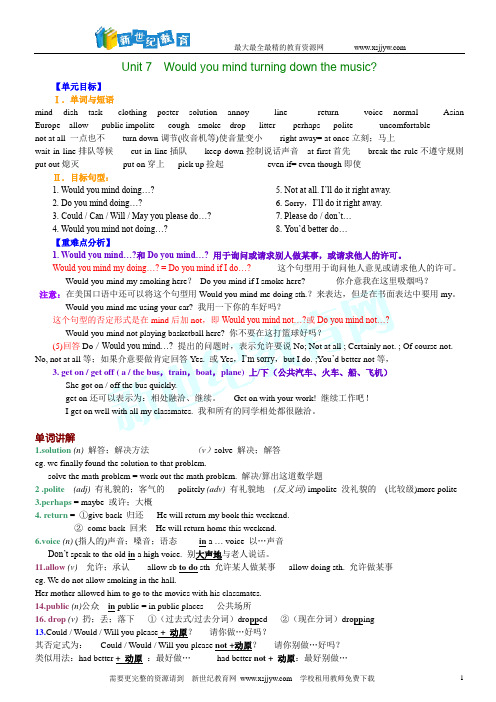
Unit 7 Would you mind turning down the music?【单元目标】Ⅰ.单词与短语mind dish task clothing poster solution annoy line return voice normal Asian Europe allow public impolite cough smoke drop litter perhaps polite uncomfortablenot at all 一点也不turn down调节(收音机等)使音量变小right away= at once立刻;马上wait in line排队等候cut in line插队keep down控制说话声音at first首先break the rule不遵守规则put out熄灭put on穿上pick up捡起even if= even though即使Ⅱ.目标句型:1. Would you mind doing…?2. Do you mind doing…?3. Could / Can / Will / May you please do…?4. Would you mind not doing…?5. Not at all. I’ll do it right away.6. Sorry,I’ll do it right away.7. Please do / don’t…8. You’d better do…【重难点分析】1. Would you mind…?和Do you mind…? 用于询问或请求别人做某事,或请求他人的许可。
Would you mind my doing…? = Do you mind if I do…? 这个句型用于询问他人意见或请求他人的许可。
Would you mind my smoking here?Do you mind if I smoke here?你介意我在这里吸烟吗?注意:在美国口语中还可以将这个句型用Would you mind me doing sth.?来表达,但是在书面表达中要用my。
八年级 下册 unit1-10 知识点总结-6
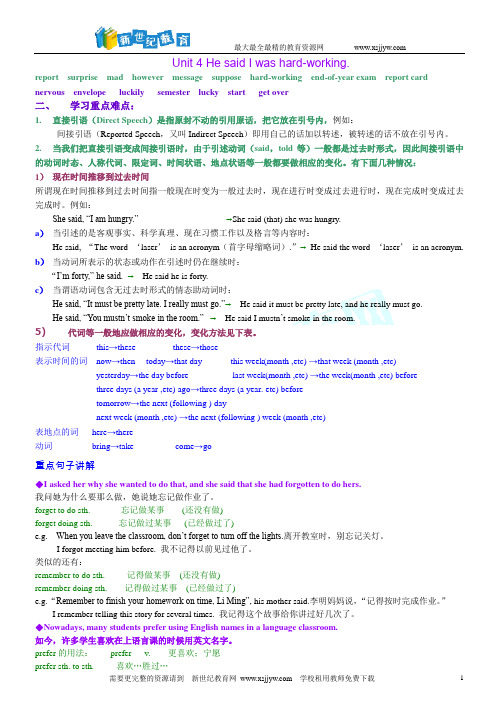
Unit 4 He said I was hard-working.report surprise mad however message suppose hard-working end-of-year exam report card nervous envelope luckily semester lucky start get over二、学习重点难点:1. 直接引语(Direct Speech)是指原封不动的引用原话,把它放在引号内,例如:间接引语(Reported Speech,又叫Indirect Speech)即用自己的话加以转述,被转述的话不放在引号内。
2. 当我们把直接引语变成间接引语时,由于引述动词(said,told等)一般都是过去时形式,因此间接引语中的动词时态、人称代词、限定词、时间状语、地点状语等一般都要做相应的变化。
有下面几种情况:1)现在时间推移到过去时间所谓现在时间推移到过去时间指一般现在时变为一般过去时,现在进行时变成过去进行时,现在完成时变成过去完成时。
例如:She said, “I am hungry.”→She said (that) she was hungry.a)当引述的是客观事实、科学真理、现在习惯工作以及格言等内容时:He said, “The word ‘laser’is an acronym(首字母缩略词).”→He said the word ‘laser’is an acronym. b)当动词所表示的状态或动作在引述时仍在继续时:“I’m forty,” he said.→He said he is forty.c)当谓语动词包含无过去时形式的情态助动词时:He said, “It must be pretty late. I really must go.”→He said it must be pretty late, and he really must go.He said, “You mustn’t smoke in the room.”→He said I mustn’t smoke in the room.5) 代词等一般地应做相应的变化,变化方法见下表。
2014新版八年级英语下册第1至第10单元知识点总结

Unit 2 I’ll help to clean up the city parks一、基本知识点1. sick 生病的,有病的;可在句中作表语Mary could not come because she is sick.也可作定语a sick child【区别ill】ill与sick同义;但是只在句中做表语,不做定语。
Mary could not come because she is ill.2. cheer (sb.) up(让某人)变得高兴;振奋起来The good news cheered up everyone in our class.3. give out分发;散发,相当于hand out,give sth. out to sb. 意为把某物分发给某人。
4. volunteer 【名词】志愿者【动词】义务做,自愿做(某事)volunteer to do sth. 自愿做某事,5. used to do sth.过去/曾经(常)做某事,表示过去的习惯、动作或状态,并强调现在已经不再存在或发生。
be used to doing sth. 习惯于做某事6. alone\by neself 无感情色彩nely (感到)孤独寂寞的feel lonely7. care for sb./sth.照顾;照料……care 【名词】小心,关心take care of=look after →【动词】care about sb./sth.关心,在意某人/事→【形容词】careful 仔细的/ careless 粗心的→【副词】carefully 仔细地8. such “这样的,这种,如此”,用于修饰名词such+ a/ an+形容词+单数名词:such a good day 多么美好的一天/such an exciting match 多么精彩的比赛such+形容词+复数名词/不可数名词:such important decisions 多么重要的建议such delicious food 多么美味的食物如果名词前被many, much, few, little修饰时,只能用so,而不用such:so many sick children/ so little time9. try out for…参加…选拔,争取成为…Thirty football players tried out for the Best Player of the year.try out试用,试验10. journey 【名词】(尤指长途)旅行,行程;trip【名词】多指短途旅行;travel【名词、动词】travel around the world →【名词】traveler旅行者11.【复习】be busy with sth. 忙于(做)什么事情be busy doing sth. 忙于(做)什么事情12.【复习】try doing sth. 试着去做某事try to do sth. 尽力去做某事try one’s best (to do sth.) 尽某人最大的努力去做某事13.【复习】be worried about sb./ sth. = worry about sb./ sth. 担心某人、某事14. raise money集资,筹钱;raise money for…为……筹钱raise【动词】举起;提高;募集15. keep【动词】keep+名词,保留(某物);keep+形容词,保持16.【形容词】broken破损的,出毛病的;blind瞎的,失明的;deaf聋的;disabled有残疾的,丧失能力的;在句中做定语和表语。
八下英语,1-10单元知识点

2014年新版八年级英语下册知识点Unit 1. what’s the matter?一.重点短语归纳1. foot---feet 脚<复> tooth---teeth 牙齿<复>2. have a cold 感冒3. have a stomachache 胃疼4. have a sore back背疼5. have a sore throat喉咙疼6. have a fever发烧7. lie down and (have a)rest 躺下休息have a rest 休息8. hot tea with honey 加蜜的热茶9. see a dentist 看牙医see a doctor 看医生10.drink lots of water多喝水11.lots of ,a lot of, a lota lot of=lots of,可以修饰可数名词复数和不可数名词,一般用在肯定句中。
:There are lots of (a lot of)books in our library.There is a lot of water on the grounda lot,是一个副词词组,跟动词连用;表示十分,很等意思;Thanks a lot.12. have a toothache牙疼13. That’s a good idea好主意14. go to bed 去睡觉go to bed early 早上床睡觉15. feel well感到好feel ill 感到不舒服I don’t feel well= I’m not feeling well我感觉不舒服.16. start doing/ to do sth开始做某事TO DO 是一件事情完成了,开始做另外一件事情DOING是原来的那件事情做到一半,现在又开始做了,是同一件事情。
17. two days ago两天前18. get some rest 多休息, 休息一会儿19. I think so我认为是这样20. be thirsty口渴21. be hungry 饥饿22. be stressed out紧张23. listen to music听音乐24. healthy lifestyle健康的生活方式25. traditional Chinese doctors传统中医26. need to do sth 需要做某事I have a toothache. I need to see a dentist. 我牙痛, 我需要去看牙医.We need to keep our classroom clean. 我们需要保持教室的干净.27. a balance of yin and yang阴阳平衡28. for example例如29. too much yin太多的阴, 阴气太盛too much + 不可数名词太多的…much too +形/副实在太…极其,非常too many + 可数名词复数太多的…30.be good for sth./ doing sth. 对什么有益,对什么有好处be bad for sth./ doing sth. 对什么有害be good to 对…好be good at =do well in 在……方面好,擅长be good(bad) for、be good at的相关用法1.be good for 对......有益Doing morning exercises is good for your health.做早操对你们的建康有益。
2014新版八年级英语下册第1至第10单元知识点总结

2014新版八年级英语下册第1-----第10单元知识点总结Unit 1 What’s the matte r?一、基础知识1. What’ s the matter? 怎么啦?出什么事情了?【解析】matter/ ' mætə(r)) /n.问题;事情What’ s the matter with you?= What’s the trouble with you? = What’ s wrong with you? 你怎么了?【注】:matter 和trouble 为名词,其前可加the 或形容词性物主代词,wrong 是adj. 不能加the【用法】用于询问某人有什么病或某人遇到什么麻烦、问题其后跟询问对象时,与介词with连用。
即:What’s the matter with sb.? = What’s your trouble? = What’s up? = What happens to sb.?—What’s the matter with you ?— I have a bad cold.2. I had a cold.我感冒了。
have a cold=catch a cold=have the flu感冒have a fever 发烧have a cough咳嗽have a stomachache胃疼,肚子疼have a toothache牙疼have a headache头疼3. 身体部位+ache(疼痛)构成新的复合词stomach+ache=stomachache head+ache=headache tooth+ache=toothache back+ache=backache后背痛4. much too+ 形容词,意为太...... ,too much+名词,意为很多,大量。
5. enough【形容、副词】足够的/地,enough放在名前后,形副后。
2015新版八年级英语下册第1至第10单元知识点总结
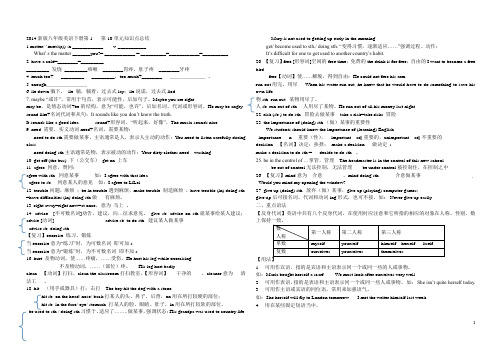
2014新版八年级英语下册第1-----第10单元知识点总结 1.matter/ ' mæt ə(r)) /n.____________ v. ___________What’ s the matter _______you?= ____________ = __________=____________=__________ 2. have a cold=________=__________________ 发烧 _________咳嗽 ________胃疼,肚子疼 ________牙疼4. much too+ _________ _________,too much+________ _______ 。
5. enough ________6. lie down 躺下, lie 躺,躺着,过去式lay ;lie 说谎,过去式lied7. maybe “或许”,常用于句首,表示可能性,后加句子。
Maybe you are right.may be ,是情态动词+be 的结构,意为“可能,也许”,后加名词、代词或形容词。
He may be angry. sound like+名词代词和从句:It sounds like you don’t know the truth. It sounds like a good idea. sound+形容词,“听起来,好像”,The music sounds nice. 9. need 需要,实义动词need+名词,需要某物;need to do sth.需要做某事,主语通常是人,表示人主动的动作:You need to listen carefully during class.need doing sth.主语通常是物,表示被动的动作:Your dirty clothes need washing. 10. get off (the bus) 下(公交车) get on 上车 11. agree 同意,赞同;agree with sth. 同意某事 如:I agree with that idea. agree to sb. 同意某人的意见 如:I agree to LiLei.12. trouble 问题,麻烦 ;be in trouble 遇到麻烦,make trouble 制造麻烦 ,have trouble (in) doing sth. =have difficulties (in) doing sth 做......有麻烦。
八下Unit1-10知识清单

同意某人/某人的意见agree with sb/sb’s ideas/opinions
达成一致意见agree on sth/doing sth (主语必须是复数)
19.幸亏/由于thanks to = because of= with the help of
11.以同样的方式一动不动sit in the same way without moving
(★without sb/sth没有.... without doing sth没有做某事)
12.看见一个老人躺在路边see a old man lying on the side of the road
(★see/watch/notice sb doing sth看见某人正在做某事)
(★see/watch/notice sb do sth看见某人做了某事)
13.大声呼救shout for help
(★shout at sb斥责某人shout to ....朝...大声喊)
14.没有多想停下公交车stop the bus without thinking twice
(★stop doing sth停止正在做的事stop to do sth停下来去做另一件事
have a headache头疼have a backache背痛
6.躺下来休息liedown andrest休息几天rest for a few days
lie
躺;处于
lay
lain
lying
lie
撒谎
lied
lied
lying
lay
下蛋,安放
八年级 下册 unit1-10 知识点总结
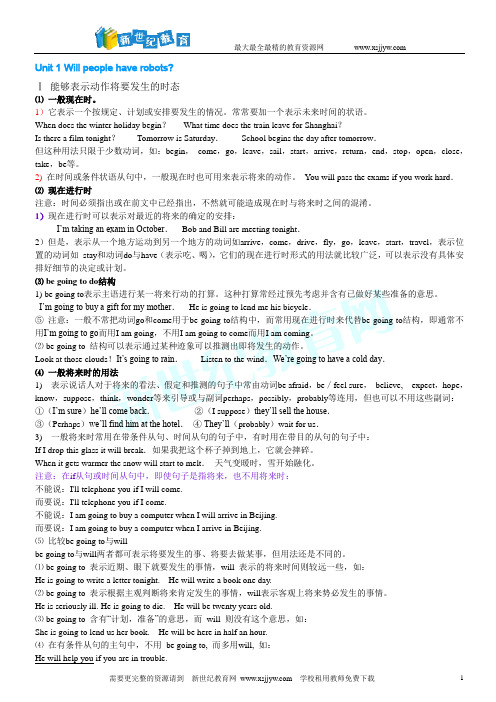
Unit 1 Will people have robots?Ⅰ能够表示动作将要发生的时态⑴一般现在时。
1)它表示一个按规定、计划或安排要发生的情况。
常常要加一个表示未来时间的状语。
When does the winter holiday begin?What time does the train leave for Shanghai?Is there a film tonight?Tomorrow is Saturday.School begins the day after tomorrow.但这种用法只限于少数动词,如:begin,come,go,leave,sail,start,arrive,return,end,stop,open,close,take,be等。
2) 在时间或条件状语从句中,一般现在时也可用来表示将来的动作。
You will pass the exams if you work hard.⑵现在进行时注意:时间必须指出或在前文中已经指出,不然就可能造成现在时与将来时之间的混淆。
1)现在进行时可以表示对最近的将来的确定的安排:I’m taking an exam in October.Bob and Bill are meeting tonight.2)但是,表示从一个地方运动到另一个地方的动词如arrive,come,drive,fly,go,leave,start,travel,表示位置的动词如stay和动词do与have(表示吃、喝),它们的现在进行时形式的用法就比较广泛,可以表示没有具体安排好细节的决定或计划。
⑶ be going to do结构1) be going to表示主语进行某一将来行动的打算。
这种打算常经过预先考虑并含有已做好某些准备的意思。
I’m going to buy a gift for my mother.He is going to lend me his bicycle.⑤注意:一般不常把动词go和come用于be going to结构中,而常用现在进行时来代替be going to结构,即通常不用I’m going to go而用I am going,不用I am going to come而用I am coming。
- 1、下载文档前请自行甄别文档内容的完整性,平台不提供额外的编辑、内容补充、找答案等附加服务。
- 2、"仅部分预览"的文档,不可在线预览部分如存在完整性等问题,可反馈申请退款(可完整预览的文档不适用该条件!)。
- 3、如文档侵犯您的权益,请联系客服反馈,我们会尽快为您处理(人工客服工作时间:9:00-18:30)。
2014新版八年级英语下册第1-----第10单元知识点总结Unit 1 What’s the matte r?一、基础知识1. What’ s the matter? 怎么啦?出什么事情了?What’ s the matter with you?= What’s the trouble with you? = What’ s wrong with you? 你怎么了?【注】:matter 和trouble 为名词,其前可加the 或形容词性物主代词,wrong 是adj. 不能加the【用法】用于询问某人有什么病或某人遇到什么麻烦、问题其后跟询问对象时,与介词with连用。
即:What’s the matter with sb.? = What’s your trouble? = What’s up? = What happens to sb.?2. I had a cold.我感冒了。
have a cold=catch a cold=have the flu感冒have a fever 发烧have a cough咳嗽have a stomachache胃疼,肚子疼have a toothache牙疼have a headache 头疼3. 身体部位+ache(疼痛)构成新的复合词stomach+ache=stomachache head+ache=headache tooth+ache=toothache back+ache=backache后背痛4. much too+ 形容词,意为太...... ,too much+名词,意为很多,大量。
5. enough【形容、副词】足够的/地,enough放在名前后,形副后。
good enough足够好,enough money=much money6. lie down躺下,lie 躺,躺着,过去式lay;lie说谎,过去式lied7. maybe ―或许‖,常用于句首,表示可能性,后加句子。
Maybe you are right.may be,是情态动词+be的结构,意为―可能,也许‖,后加名词、代词或形容词。
He may be angry.sound like+名词代词和从句:It sounds like you don’t know the truth.It sounds like a good idea.sound+形容词,―听起来,好像‖,The music sounds nice.9. need 需要,实义动词need+名词,需要某物;need to do sth.需要做某事,主语通常是人,表示人主动的动作:You need to listen carefully during class.need doing sth.主语通常是物,表示被动的动作:Your dirty clothes need washing.10. get off (the bus) 下(公交车)get on 上车11. agree 同意,赞同;agree with sth. 同意某事如:I agree with that idea.agree to sb. 同意某人的意见如:I agree to LiLei.12. trouble问题,麻烦;be in trouble遇到麻烦,make trouble 制造麻烦,have trouble (in) doing sth. =have difficulties (in) doing sth做......有麻烦。
13. right away=right now=at once,意为马上。
14. advice [不可数名词]劝告,建议,向…征求意见,give sb. advice on sth.就某事给某人建议;advise [动词] advise sb. to do sth. 建议某人做某事advise doing sth.【复习】exercise 练习、锻炼当exercise意为―练习‖时,为可数名词即可加s当exercise意为―锻炼‖时,为不可数名词即不加s18. hit (用手或器具)打;击打The boy hit the dog with a stone.hit sb. on the head/ nose/ back打某人的头、鼻子、后背,on用在所打较硬的部位;hit sb. in the face/ eye/ stomach 打某人的脸、眼睛、肚子,in用在所打较软的部位。
be used to sth./ doing sth.习惯于、适应了……、做某事,强调状态;get/ become used to sth./ doing sth. ―变得习惯,逐渐适应……‖强调过程、动作:.20. 【复习】free [形容词]空闲的free time ;免费的the drink is for free ;自由的I want to become a free bird.free 【动词】使……解脱,得到自由:He could not free his arm.run out 用完,用尽物sth. run out. 某物用尽了。
人sb. run out of sth. 人用尽了某物。
22. risk (sb.) to do sth. 冒险去做某事 take a risk=take risks 冒险23. the importance of (doing) sth.(做)某事的重要性importance n. 重要(性), important adj.重要的,unimportant adj.不重要的decision 【名词】决定;抉择; make a decision 做决定 ;make a decision to do sth.= decide to do sth. 。
25. be in the control of …掌管,管理 The headmaster is in the control of this new school.be out of control 无法控制,无法管理 be under control 被控制住,在控制之中26. 【复习】mind 意为 介意 ,mind doing sth. 介意做某事 ,27. give up (doing) sth. 放弃(做)某事,give up 后可接名词、代词和动词ing 形式,也可不接二、重点语法【反身代词】英语中共有八个反身代词,在使用时应注意和它所指的相应的对象在人称、性别、数上保持一致。
1. 可用作宾语,指的是宾语和主语表示同一个或同一些的人或事物。
如:Maria bought herself a scarf. We must look after ourselves very well.2. 可用作表语,指的是表语和主语表示同一个或同一些人或事物。
如: She isn’t quite herself today.3. 可用作主语或宾语的同位语,常用来加强语气。
如:She herself will fly to London tomorrow. I met the writer himself last week.4. 用在某些固定短语当中。
look after oneself / take care of oneself 照顾自己 teach oneself sth./ learn sth. by oneself 自学 enjoy oneself 玩得高兴,过得愉快 help oneself to sth 请自用……(随便吃/喝些……). hurt oneself 摔伤自己say to oneself 自言自语leave sb. by oneself 把某人单独留下buy oneself sth.给自己买……东西introduce oneself 介绍……自己【提醒】1. 反身代词不能单独做主语,但可以做主语的同位语,起强调作用。
如:我自己能完成作业。
(误)Myself can finish my homework. (正) I myself can finish my homework. / I can finish my homework myself.2. 反身代词表示―某人自己‖不能表示―某人的东西‖,因为它没有所有格的形式。
表达―某人自己的(东西)‖时,须要用one’s own.如:我用我自己的蜡笔画画。
(误)I’m drawing with myself crayons. (正) I’m d rawing with my own crayons.Unit 2 I’ll help to clean up the city parks一、基本知识点1. sick 生病的,有病的;可在句中作表语Mary could not come because she is sick.也可作定语a sick child【区别ill】ill与sick同义;但是只在句中做表语,不做定语。
Mary could not come because she is ill.2. cheer (sb.) up(让某人)变得高兴;振奋起来The good news cheered up everyone in our class.3. give out分发;散发,相当于hand out,The teacher is giving out/ handing out the test papers.give sth. out to sb. 意为把某物分发给某人。
4. volunteer 【名词】志愿者【动词】义务做,自愿做(某事)volunteer to do sth. 自愿做某事,The girls could volunteer in an after-school study program.5. used to do sth.过去/曾经(常)做某事,表示过去的习惯、动作或状态,并强调现在已经不再存在或发生。
6. alone 【形容词】独自一人的,无感情色彩lonely (感到)孤独寂寞的,带有很强的感情色彩,可做表语或定语。
7. care for sb./sth.照顾;照料……care 【名词】小心,关心take care of=look after →【动词】care about sb./sth.关心,在意某人/事→【形容词】careful 仔细的/ careless 粗心的→【副词】carefully 仔细地8. such ―这样的,这种,如此‖,用于修饰名词such+ a/ an+形容词+单数名词:such a good day 多么美好的一天/such an exciting match 多么精彩的比赛such+形容词+复数名词/不可数名词:such important decisions 多么重要的建议such delicious food 多么美味的食物如果名词前被many, much, few, little修饰时,只能用so,而不用such:so many sick children/ so little time9. try out for…参加…选拔,争取成为…try out试用,试验10. journey 【名词】(尤指长途)旅行,行程;trip【名词】多指短途旅行;travel【名词、动词】travel around the world →【名词】traveler旅行者11.be busy with sth. 忙于(做)什么事情be busy doing sth. 忙于(做)什么事情12.try doing sth. 试着去做某事try to do sth. 尽力去做某事try one’s best (to do sth.) 尽某人最大的努力去做某事13.be worried about sb./ sth. = worry about sb./ sth. 担心某人、某事14. raise money集资,筹钱;raise money for…为……筹钱raise【动词】举起;提高;募集15. keep【动词】keep+名词,保留(某物);keep+形容词,保持16.【形容词】broken破损的,出毛病的;blind瞎的,失明的;deaf聋的;disabled有残疾的,丧失能力的;在句中做定语和表语。
